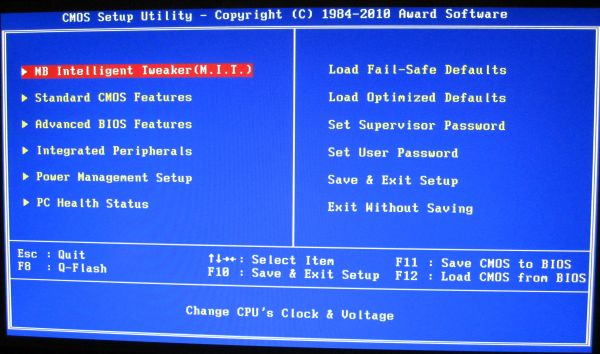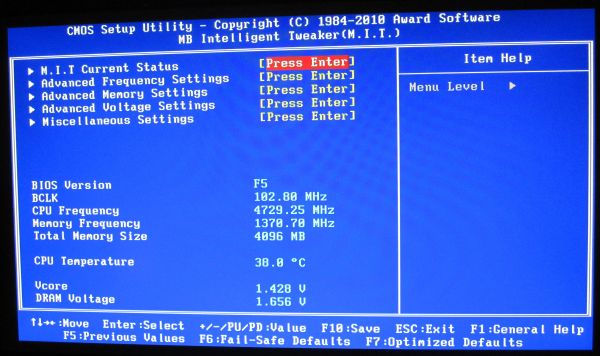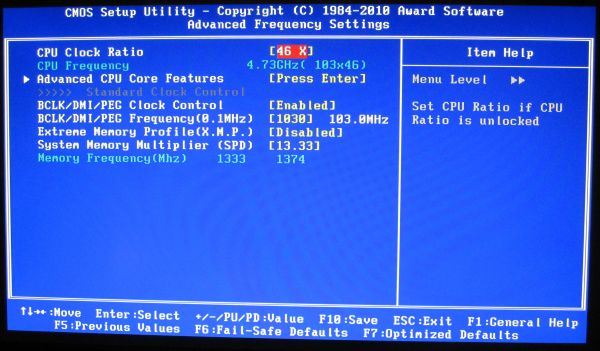The Battle of the P67 Boards - ASUS vs. Gigabyte at $190
by Ian Cutress on January 20, 2011 4:15 PM EST- Posted in
- Motherboards
- Gigabyte
- Asus
- P67
BIOS
Gigabyte has not been on the ball BIOS/UEFI wise for Sandy Bridge. In the Visual Inspection, I explained at how the board is actually 64-bit UEFI but with a BIOS interface attached (for stability, after years of working at it) with plans to possibly upgrade to a GUI at a later date. Though in the name of stability, the launch BIOS has significant issues with turbo boosting, where only a 1x multiplier boost gets applied at any thread loading, rather than 4x/3x/2x. It wasn't as simple as downloading the latest BIOS from the website and updating - in order to get it to work properly, I had to load in an OS, and download the latest version of @BIOS, their BIOS updating tool, and grab the latest BIOS. You cannot use the version of @BIOS on the CD, you need the latest version, and you cannot use QFlash in the BIOS, as they both do not recognise any BIOS F6 or above as valid. I downloaded the latest BIOS file from the website, and use @BIOS to update from the file. At the time of writing, the F7b BIOS is the latest, which implements turbo modes correctly.
If you have worked with a BIOS before, Gigabyte is not throwing up too many new features to surprise you – only those based around Sandy Bridge. Everything overclocking, CPU and voltage related is found in the Intelligent Tweaker menu, whereas boot order can be found in the advanced BIOS options.
The Intelligent Tweaker menu gives a quick overview of BCLK, frequency, temperature, voltages, etc. By dividing the all the OC options into the ‘frequency’, ‘memory’, and ‘voltage’ sub-menus, while this splits up the options to make them easier to digest, it does result in more navigation. Personally, I would prefer being able to adjust the CPU/DRAM voltages in the frequency settings as well as the voltage settings.
Thankfully, most of the settings can be adjusted by typing in a value, or by the +/- buttons, or by pressing enter to type/bring a scrollable menu up. I like being able to do this in a BIOS/UEFI, and most manufacturers will leave out at least one of the available ways to change a setting in every sub-menu, or mix and match as they deem appropriate.
The BIOS allows eight profiles to be saved on board, or you can save/load to a file. Given some of the overclocking problems I mention below, every time a re-flash of the BIOS was required, all my saved on board settings were lost.
Overclocking
Overclocking on the P67-UD4 was almost as easy as it has been on previous BIOS boards, although there was no easy overclock presets available in the BIOS. EasyTune6, the OS software on the Gigabyte CD, gives automatic options for 35x, 37x and 40x multiplier at 100 MHz bus speed. These settings, as in previous Gigabyte iterations and boards, work pretty well, but a 4 GHz overclock on Sandy Bridge is not going to win any awards.
Going into the BIOS, I immediately left everything on auto and upped the multiplier to 45x, for a 4.5 GHz processor speed. This successfully booted into Windows, passed the stability tests, then BSOD on shutdown. On the restart, the board attempted to boot back at stock, which was disappointing.
As with previous overclocking attempts, I jumped in and put the VCore straight at 1.42V, with a 1.9V PLL. Upping the multiplier to 45x to give 4.5 GHz this time was no trouble. 4.6 GHz and 4.7 GHz also passed without issue. 4.8 GHz booted into the OS, but failed the OCCT stress test, so I rolled back the multiplier to 47x and started playing with the BCLK by 1 MHz at a time. 101 MHz also failed the stress test, leaving 47 * 100 MHz as a good overclock. This board automatically puts a -0.2 MHz bias on the BCLK, meaning that the speed is actually 47 * 99.8 MHz = 4.69 GHz.
Out of interest, I rolled back the multiplier again to 46x and upped the BCLK this way. With a 102.2 MHz BCLK, it would beat the speed of the 47 * 100 MHz overclock, so I booted at 102.5 MHz (102.3 MHz effective), with a 46x multiplier, which passed. 103 MHz did not however, so 102.5 MHz * 46 (102.3 MHz * 46 effective = 4706 MHz) would seem the best option, as it contains that small little BCLK boost to help other components and memory.
With the board’s Dual BIOS system, on a severe failed boot type unsuccessful overclock by increasing the multiplier too much, the board would revert to the backup BIOS, and then boot me straight into the BIOS. If I changed anything, it would load the standard BIOS again with my new settings. Also of note, if I upped the BCLK too far, the system would restart in one of two ways – without any overclock at all, or at 100 MHz with my chosen multiplier. If I increased the RAM too far, it would keep rebooting and never getting to the POST screen until I used a jumper on the Clear CMOS header. Note, no jumpers are included in the box, so you have to find your own way of shorting those pins. I also tried going for 50x multiplier, 100 MHz BCLK, at 1.50 V. On a failed boot into Windows, the main BIOS became corrupted and had to be restored by the backup – then I had to load into the OS to run @BIOS to update to the F7b BIOS again, because the backup BIOS is F1 and doesn’t recognise the F7b BIOS file as a valid BIOS, which was frustrating.
At 4.706 GHz (42.6% OC over 3.3 GHz/non turbo/multithreaded, 27% OC over 3.7 GHz/turbo/single-threaded), the 3D Movement benchmark was run. In single thread mode, a score of 145.19 was achieved, a 28% increase. In multi-threaded mode, a score of 463.12 was achieved, a 38.6% increase.



















137 Comments
View All Comments
publiorama - Sunday, January 23, 2011 - link
I have a serious question about these mobos.Both Asus and Gigabyte P67 motherboards don't have "VT-D enable" option in their BIOS, whereas P55 does. Asrock P67 have it.
So up to now, VT-D are non usable on Asus and Gb.
What the hell is this ?? You got a CPU with VT-D and you cannot use it ??
Have you some info about this ??
That is a huge problem for many people.
Cashano - Sunday, January 23, 2011 - link
You need a non-K CPU (ii5-2400, i5-2500, i7-2600), so this wont be used for any OC-PC builder.Cashano
publiorama - Sunday, January 23, 2011 - link
It's sure you need a non-K CPU.I'm talking about motherboards.
In Asus and Gb mobos there's NO VT-D option at all. In asrock P67 there is, and even the old asus P55 have that option.
I'am asking if someone knows if VT-D support in Asus and Gb will be in some BIOS update, or watherver else.
akula2 - Friday, February 4, 2011 - link
I'm not sure about P67 Vt-d from Gigabyte or Asus, yet. But P55 offers the Vt-d support.Next, if you are looking for P67 with Vt-d, then get Intel's Extreme Series board, DP67BG (but wait till April, till Intel replaces its stock):
http://www.intel.com/support/motherboards/desktop/...
That MOBO fares very well, check out some reviews. But if you are OC freak, especially compare everything with Gigabyte/Asus then forget it.
As of today, I've suspended procuring P67 MOBOs because of SATA bug plus Vt-d wasn't clear enough. I've to wait till April or so.
radium69 - Sunday, January 23, 2011 - link
I remember when I used to buy my Abit IP35 PRO "Off limits" it cost me $150 . It had nearly EVERYTHING, and it was a great motherboard. It's still going rocksolid with a modest overclock for over 3 years?I have build a lot of PCs, which housed a GIGABYTE DS3L motherboard, damn great motherboard, great features. And the price? $110. Overclockability? Just simply awesome. Running some older core 2 duo's with a modest overclock of 400/500mhz.
BSOD's? NONE all in 2-3 years so far.
It was THE bang for the budget motherboard for normal users. Offcourse we are all enthousiasts, but that doesn't mean we have enthousiast wallets...
And for $190, it SHOULD come with just about everything AND have high quality parts.
It's just that simple. I'lll be waiting for the sub $150 in depth reviews. That's where the majority is at. And so should you (anandtech) too.
knirfie - Tuesday, January 25, 2011 - link
Too bad LAN performance wasn't compared, this is often ignored because nearly all boards use Realtek cr*p.However, the Asus board uses an Intel solution, it would be interesting to see how badly the Intel chip beats the RTL8111 in terms of CPU load, throughput, etc.
spikexp - Tuesday, January 25, 2011 - link
So if I can get a p8p67 pro + 2500k for the same price (exact same) of aASRock P67 Extreme4 + 2500k.
The p8p67 pro would be better?
TyroneTab - Wednesday, May 6, 2020 - link
asian cam girls https://hotcamgirls1.com">teen girls cam sexy webcam girl.Ronaldbeaus - Wednesday, May 6, 2020 - link
sex cam live https://bestonlinesexwebcams.com">bestonlinesexwebcams.com skype webcam sex homemade.asian cam sites https://adultcamsites1.com">couples cam sites video cam site.
free web cam sex https://bestonlinesexcams1.com">bestonlinesexcams1.com free ebony sex cam.
teen cam sex https://bestonlinesexwebcams.com">bestonlinesexwebcams.com sexcams.
free web cam sites https://adultcamsites1.com">adultcamsites1.com diaper girl webcam sites.
web cam sites https://adultfreewebcamsites.com">adultfreewebcamsites.com trans cam site.
Robertroary - Wednesday, May 6, 2020 - link
webcam sex live https://bestonlinesexcams1.com">bestonlinesexcams1.com free cam sex chat.teen webcam sex videos https://bestonlinesexcams1.com">filipina sex cam webcam sex chat.
adult web cam sites https://adultfreewebcamsites.com">highest paying cam sites mobile cam sites.